Angular Momentum and Its Conservation
- Understand the analogy between angular momentum and linear momentum.
- Observe the relationship between torque and angular momentum.
- Apply the law of conservation of angular momentum.
Why does Earth keep on spinning? What started it spinning to begin with? And how
does an ice skater manage to spin faster and faster simply by pulling her arms
in? Why does she not have to exert a torque to spin faster? Questions like these
have answers based in angular momentum, the rotational analog to linear
momentum.
By now the pattern is clear—every rotational phenomenon has a direct
translational analog. It seems quite reasonable, then, to define angular
momentum $L$ as
$$ L=I \omega. $$
This equation is an analog to the definition of linear momentum as $p=mv$.
Units for linear momentum are $\kg \cdot \ms$ while units for angular
momentum are $\kg \cdot \mms$. As we would expect, an object that has a
large moment of inertia $I$, such as Earth, has a very large angular
momentum. An object that has a large angular velocity $\omega$, such as a
centrifuge, also has a rather large angular momentum.
Making Connections
Angular momentum is completely analogous to linear momentum, first presented in Uniform Circular Motion and Gravitation. It has the same implications in terms of carrying rotation forward, and it is conserved when the net external torque is zero. Angular momentum, like linear momentum, is also a property of the atoms and subatomic particles.
Calculating Angular Momentum of the Earth
Strategy
No information is given in the statement of the problem; so we must look up
pertinent data before we can calculate $L=I \omega$. First, according
to Figure 3 of Dynamics Of Rotational Motion, the formula for
the moment of inertia of a sphere is
$$ I=\frac{2 MR^{2}}{5} $$
so that
$$ L=I\omega=\frac{2 MR^{2}\omega }{5}. $$
Earth’s mass $M$ is $5.972 \times 10^{24}\kg$ and its radius $R$ is $6.376 \times 10^{6}\m$. The Earth’s angular velocity $\omega$ is, of course,
exactly one revolution per day, but we must covert $\omega$ to radians per
second to do the calculation in SI units.
Solution
Substituting known information into the expression for $L$ and converting $\omega$ to radians per second gives
$$ \begin{array}{lll}
L&=& 0.4\left(5.972 \times 10^{24}\kg \right){\left(6.376 \times 10^{6}\m \right)}^{2}\left(\frac{1\text{rev}}{\text{d}}\right)\\
L&=& 9.72 \times 10^{37}\kg \cdot \mm\cdot \text{rev/d}.
\end{array} $$
Substituting $2\pi$ rad for $1$ rev and $8.64 \times 10^{4}\s$ for 1 day gives
$$ \begin{array}{lll}
L&=& \left(9.72 \times 10^{37}\kg \cdot \mm\right)\left(\frac{2\pi \text{rad/rev}}{8.64 \times 10^{4}\text{s/d}}\right)\left(1\text{rev/d}\right)\\
L&=& 7.07 \times 10^{33}\kg \cdot \mms .
\end{array} $$
Discussion
This number is large, demonstrating that Earth, as expected, has a tremendous
angular momentum. The answer is approximate, because we have assumed a constant
density for Earth in order to estimate its moment of inertia.
When you push a merry-go-round, spin a bike wheel, or open a door, you exert a
torque. If the torque you exert is greater than opposing torques, then the
rotation accelerates, and angular momentum increases. The greater the net
torque, the more rapid the increase in $L$. The relationship between torque
and angular momentum is
$$ \text{net}\tau =\frac{ \Delta L}{\Delta t}. $$
This expression is exactly analogous to the relationship between force and
linear momentum, $F=\Delta p/\Delta t$. The equation $\text{net}\tau =\frac{ \Delta L}{\Delta t}$ is very fundamental and broadly applicable. It
is, in fact, the rotational form of Newton’s second law.
Calculating the Torque Putting Angular Momentum Into a Lazy Susan
Figure 1 shows a Lazy Susan food tray being rotated by a person in quest of sustenance. Suppose the person exerts a 2.50 N force perpendicular to the lazy Susan’s 0.260-m radius for 0.150 s.
(a) What is the final angular momentum of the lazy Susan if it starts from rest, assuming friction is negligible?
(b) What is the final angular velocity of the lazy Susan, given that its mass is 4.00 kg and assuming its moment of inertia is that of a disk?
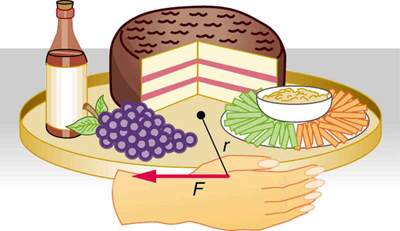
Strategy
We can find the angular momentum by solving $\text{net}\tau =\frac{ \Delta L}{\Delta t}$ for $\Delta L$, and using the given information to calculate
the torque. The final angular momentum equals the change in angular momentum,
because the lazy Susan starts from rest. That is, $\Delta L=L$. To find the
final velocity, we must calculate $\omega$ from the definition of $L$ in
$L=I \omega$.
Solution for (a)
Solving $\text{net}\tau =\frac{ \Delta L}{\Delta t}$ for $\Delta L$
gives
$$ \Delta L=\left(\text{net}\text{τ}\right)\Delta t . $$
Because the force is perpendicular to $r$,
we see that $\text{net}\tau =rF$, so that
$$ \begin{array}{lll}
L&=& rF\Delta t=\left(0.260 \m \right)\left(2.50 N\right)\left(0.150 s\right)
=& 9.75 \times 10^{-2}\kg \cdot \mm/\s .
\end{array} $$
Solution for (b)
The final angular velocity can be calculated from the definition of angular
momentum,
$$ L=I \omega. $$
Solving for $\omega$ and substituting the formula
for the moment of inertia of a disk into the resulting equation gives
$$ \omega =\frac{L}{I}=\frac{L}{\frac{1}{2}M R^{2}}. $$
And substituting known values into the preceding equation yields
$$ \omega =\frac{9.75 \times 10^{-2}\kg \cdot \mms }{\left(0.500\right)\left(4.00\kg \right)\left(0.260\m \right)}=0.721\rads . $$
Discussion
Note that the imparted angular momentum does not depend on any property of the
object but only on torque and time. The final angular velocity is equivalent to
one revolution in 8.71 s (determination of the time period is left as an
exercise for the reader), which is about right for a lazy Susan.
Calculating the Torque in a Kick
The person whose leg is shown in Figure 2 kicks his leg by exerting a 2000-N force with his upper leg muscle. The effective perpendicular lever arm is 2.20 cm.
Given the moment of inertia of the lower leg is $1.25 \kg\cdot \mm$,
(a) find the angular acceleration of the leg.
(b) Neglecting the gravitational force, what is the rotational kinetic energy of the leg after it has rotated
through $57.3^\circ$
(1.00 rad)?
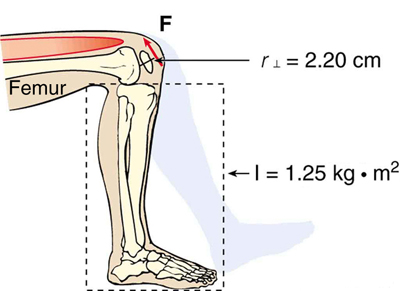
Strategy
The angular acceleration can be found using the rotational analog to Newton’s
second law, or $\alpha =\text{net}\tau /I$. The moment of inertia $I$ is
given and the torque can be found easily from the given force and perpendicular
lever arm. Once the angular acceleration $\alpha$ is known, the final
angular velocity and rotational kinetic energy can be calculated.
Solution to (a)
From the rotational analog to Newton’s second law, the angular acceleration $\alpha$ is
$$ \alpha =\frac{ \text{net}\tau }{I}. $$
Because the force and the perpendicular lever arm are given and the leg is vertical
so that its weight does not create a torque, the net torque is thus
$$ \begin{array}{lll}
\text{net}\tau &=& r_{\perp }F\\
\text{net}\tau &=& \left(0.0220 \m \right)\left(2000\N \right)\\
\text{net}\tau &=& 44.0 \N \cdot \m .
\end{array} $$
Substituting this value for the torque and the given value for the moment of inertia into the expression for $\alpha$
gives
$$ \alpha =\frac{44.0\N \cdot \m }{1.25\kg \cdot \mm}=35.2 \radss . $$
Solution to (b)
The final angular velocity can be calculated from the kinematic expression
$$ \omega^{2}=\omega_{0}^{2}+2 \alpha \theta $$
or
$$ \omega^{2}=2 \alpha \theta $$
because the initial angular velocity is zero. The kinetic energy of rotation is
$$ \KE_{\text{rot}}=\frac{1}{2}I\omega^{2} $$
so it is most convenient to use the value of $\omega^{2}$ just
found and the given value for the moment of inertia. The kinetic energy is
then
$$ \begin{array}{lll}
\KE_\text{rot} &=& 0.5\left(1.25\kg \cdot \mm\right)
\left(70.4{\text{rad}}^{2}/{\s}^{2}\right)\\
\KE_\text{rot} &=& 44.0 \J
\end{array}. $$
Discussion
These values are reasonable for a person kicking his leg starting from the
position shown. The weight of the leg can be neglected in part (a) because it
exerts no torque when the center of gravity of the lower leg is directly beneath
the pivot in the knee. In part (b), the force exerted by the upper leg is so
large that its torque is much greater than that created by the weight of the
lower leg as it rotates. The rotational kinetic energy given to the lower leg is
enough that it could give a ball a significant velocity by transferring some of
this energy in a kick.
Making Connections: Conservation Laws
Angular momentum, like energy and linear momentum, is conserved.
This universally applicable law is another sign of underlying unity in physical laws.
Angular momentum is conserved when net external torque is zero, just as linear
momentum is conserved when the net external force is zero.
Conservation of Angular Momentum
We can now understand why Earth keeps on spinning. As we saw in the previous
example, $\Delta L=\left(\text{net}\tau \right)\Delta t$. This equation
means that, to change angular momentum, a torque must act over some period of
time. Because Earth has a large angular momentum, a large torque acting over a
long time is needed to change its rate of spin. So what external torques are
there? Tidal friction exerts torque that is slowing Earth’s rotation, but tens
of millions of years must pass before the change is very significant. Recent
research indicates the length of the day was 18 h some 900 million years ago.
Only the tides exert significant retarding torques on Earth, and so it will
continue to spin, although ever more slowly, for many billions of years.
What we have here is, in fact, another conservation law. If the net torque is
zero, then angular momentum is constant or conserved. We can see this
rigorously by considering $\text{net}\tau =\frac{ \Delta L}{\Delta t}$ for
the situation in which the net torque is zero. In that case,
$$ \text{net}\tau =0 $$
implying that
$$ \frac{ \Delta L}{\Delta t}=0. $$
If the change in angular momentum $\Delta L$ is zero, then the angular
momentum is constant; thus,
$$ L=\text{constant}; \left(\text{net}\tau =0\right) $$
or
$$ L=L^{\prime} ; \left(\text{net }\tau =0\right). $$
These expressions are the law of conservation of angular momentum.
Conservation laws are as scarce as they are important.
An example of conservation of angular momentum is seen in Figure 3, in
which an ice skater is executing a spin. The net torque on her is very close to
zero, because there is relatively little friction between her skates and the ice
and because the friction is exerted very close to the pivot point. (Both $F$
and $r$ are small, and so $\tau$ is negligibly small.) Consequently, she
can spin for quite some time. She can do something else, too. She can increase
her rate of spin by pulling her arms and legs in. Why does pulling her arms and
legs in increase her rate of spin? The answer is that her angular momentum is
constant, so that
$$ L=L^{\prime} . $$
Expressing this equation in terms of the moment of inertia,
$$ I\omega =I^{\prime} \omega^\prime , $$
where the primed quantities refer to conditions after she has pulled in her arms
and reduced her moment of inertia. Because $I^{\prime}$ is smaller, the
angular velocity $\omega \prime$ must increase to keep the angular momentum
constant. The change can be dramatic, as the following example shows.
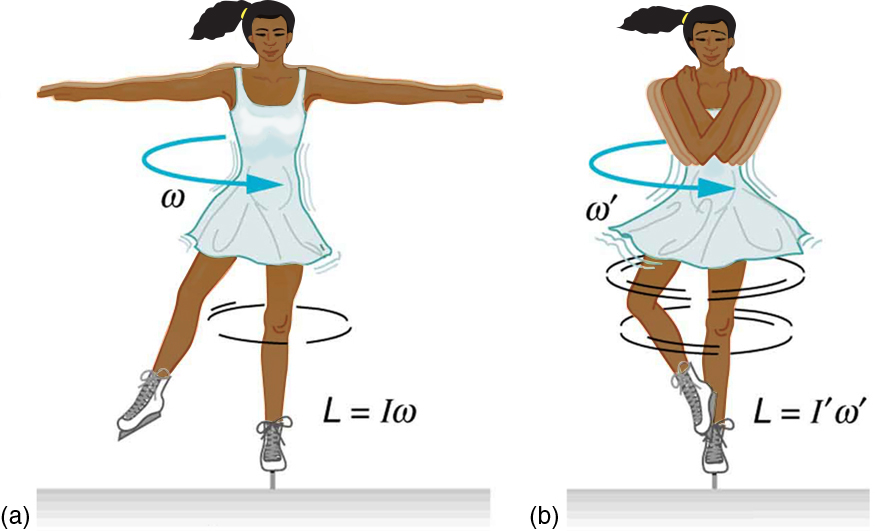
Calculating the Angular Momentum of a Spinning Skater
Suppose an ice skater, such as the one in Figure 3, is spinning
at 0.800 rev/ s with her arms extended. She has a moment of inertia of $2.34\kg \cdot \mm$
with her arms extended and of $0.363\kg \cdot \mm$ with her
arms close to her body. (These moments of inertia are based on reasonable
assumptions about a 60.0-kg skater.) (a) What is her angular velocity in
revolutions per second after she pulls in her arms?
(b) What is her rotational kinetic energy before and after she does this?
Strategy
In the first part of the problem, we are looking for the skater’s angular
velocity $\omega \prime$ after she has pulled in her arms. To find this
quantity, we use the conservation of angular momentum and note that the moments
of inertia and initial angular velocity are given. To find the initial and final
kinetic energies, we use the definition of rotational kinetic energy given by
$$ \KE_{\text{rot}}=\frac{1}{2}I\omega^{2}. $$
Solution for (a)
Because torque is negligible (as discussed above), the conservation of angular
momentum given in $I\omega = I^{\prime} \omega^\prime$ is applicable. Thus,
$$ L=L^{\prime} $$
or
$$ I\omega=I^{\prime} \omega^\prime $$
Solving for $\omega \prime$ and substituting known values into the resulting equation gives
$$ \begin{array}{lll}
\omega \prime &=& \frac{I}{I^{\prime}}\omega
=\left(\frac{2.34 \kg \cdot {m}^{2}}{0.363 \kg \cdot {m}^{2}}\right)
\left(0.800 \text{rev/s}\right)\\
\omega \prime &=& 5.16 \text{rev/s.}
\end{array} $$
Solution for (b)
Rotational kinetic energy is given by
$$ \KE_{\text{rot}}=\frac{1}{2}I\omega^{2}. $$
The initial value is found by substituting known values into the equation and converting the angular velocity to rad/s:
$$ \begin{array}{lll}
\KE_\text{rot} &=& \left(0.5\right)\left(2.34\kg \cdot \mm\right){\left(\left(0.800\text{rev/s}\right)\left(2\pi \text{rad/rev}\right)\right)}^{2}\\
\KE_\text{rot} &=& 29.6 \J .
\end{array} $$
The final rotational kinetic energy is
$$ \KE_{\text{rot}}\prime =\frac{1}{2}I^{\prime} {\omega \prime }^{2}. $$
Substituting known values into this equation gives
$$ \begin{array}{lll}
\KE_\text{rot}^\prime &=& \left(0.5\right)\left(0.363 \kg \cdot {m}^{2}\right){\left[\left(5.16 \text{rev/s}\right)\left(2\pi rad/rev\right)\right]}^{2}\\
\KE_\text{rot}^\prime &=& 191 \J .
\end{array} $$
Discussion
In both parts, there is an impressive increase. First, the final angular
velocity is large, although most world-class skaters can achieve spin rates
about this great. Second, the final kinetic energy is much greater than the
initial kinetic energy. The increase in rotational kinetic energy comes from
work done by the skater in pulling in her arms. This work is internal work that
depletes some of the skater’s food energy.
There are several other examples of objects that increase their rate of spin
because something reduced their moment of inertia. Tornadoes are one example.
Storm systems that create tornadoes are slowly rotating. When the radius of
rotation narrows, even in a local region, angular velocity increases, sometimes
to the furious level of a tornado. Earth is another example. Our planet was born
from a huge cloud of gas and dust, the rotation of which came from turbulence in
an even larger cloud. Gravitational forces caused the cloud to contract, and the
rotation rate increased as a result. (
See Figure 4.)
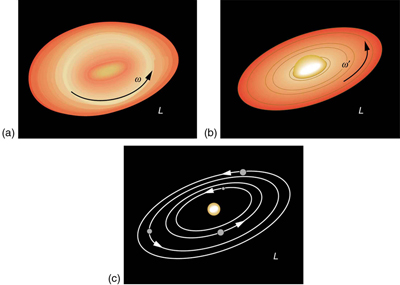
In case of human motion, one would not expect angular momentum to be conserved
when a body interacts with the environment as its foot pushes off the ground.
Astronauts floating in space aboard the International Space Station have no
angular momentum relative to the inside of the ship if they are motionless.
Their bodies will continue to have this zero value no matter how they twist
about as long as they do not give themselves a push off the side of the vessel.
Check Your Understanding
Is angular momentum completely analogous to linear momentum? What, if any, are their differences?
Yes, angular and linear momentums are completely analogous. While they are exact analogs they have different units and are not directly inter-convertible like forms of energy are.
Section Summary
- Every rotational phenomenon has a direct translational analog, likewise
angular momentum $L$ can be defined as $L=I \omega.$
- This equation is an analog to the definition of linear momentum as $p=mv$.
The relationship between torque and angular momentum is $\text{net}\tau =\frac{ \Delta L}{\Delta t}.$
- Angular momentum, like energy and linear momentum, is conserved. This
universally applicable law is another sign of underlying unity in physical
laws. Angular momentum is conserved when net external torque is zero, just as
linear momentum is conserved when the net external force is zero.
Conceptual Questions
When you start the engine of your car with the transmission in neutral, you notice that the car rocks in the opposite sense of the engine’s rotation. Explain in terms of conservation of angular momentum. Is the angular momentum of the car conserved for long (for more than a few seconds)?
Suppose a child walks from the outer edge of a rotating merry-go round to the inside. Does the angular velocity of the merry-go-round increase, decrease, or remain the same? Explain your answer.
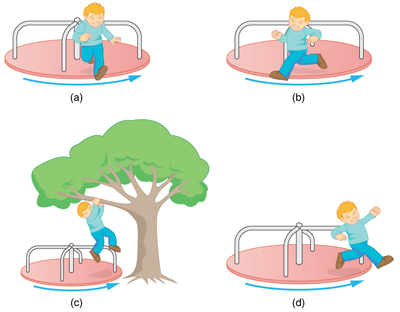
Suppose a child gets off a rotating merry-go-round. Does the angular velocity of the merry-go-round increase, decrease,
or remain the same if:
(a) He jumps off radially?
(b) He jumps backward to land motionless?
(c) He jumps straight up and hangs onto an overhead tree branch?
(d) He jumps off forward, tangential to the edge? Explain your answers. (Refer to Figure 5).
Helicopters have a small propeller on their tail to keep them from rotating in the opposite direction of their main lifting blades. Explain in terms of Newton’s third law why the helicopter body rotates in the opposite direction to the blades.
Whenever a helicopter has two sets of lifting blades, they rotate in opposite directions (and there will be no tail propeller). Explain why it is best to have the blades rotate in opposite directions.
Describe how work is done by a skater pulling in her arms during a spin. In particular, identify the force she exerts on each arm to pull it in and the distance each moves, noting that a component of the force is in the direction moved. Why is angular momentum not increased by this action?
When there is a global heating trend on Earth, the atmosphere expands and the length of the day increases very slightly. Explain why the length of a day increases.
Nearly all conventional piston engines have flywheels on them to smooth out engine vibrations caused by the thrust of individual piston firings. Why does the flywheel have this effect?
Jet turbines spin rapidly. They are designed to fly apart if something makes them seize suddenly, rather than transfer angular momentum to the plane’s wing, possibly tearing it off. Explain how flying apart conserves angular momentum without transferring it to the wing.
An astronaut tightens a bolt on a satellite in orbit. He rotates in a direction opposite to that of the bolt,
and the satellite rotates in the same direction as the bolt. Explain why. If a handhold is available on the satellite,
can this counter-rotation be prevented? Explain your answer.
Competitive divers pull their limbs in and curl up their bodies when they do flips. Just before entering the water, they fully extend their limbs to enter straight down. Explain the effect of both actions on their angular velocities. Also explain the effect on their angular momenta.
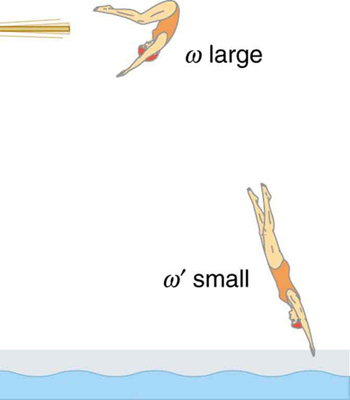
Draw a free body diagram to show how a diver gains angular momentum when leaving the diving board.
In terms of angular momentum, what is the advantage of giving a football or a rifle bullet a spin when throwing or releasing it?
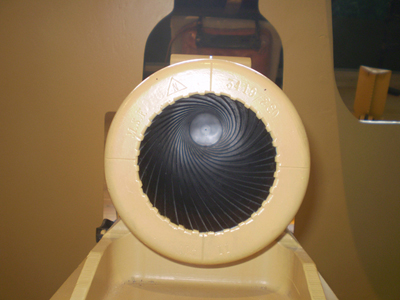
Problems & Exercises
(a) Calculate the angular momentum of the Earth in its orbit around the Sun.
(b) Compare this angular momentum with the angular momentum of Earth on its
axis.
Strategy
For part (a), we treat Earth as a point mass orbiting the Sun and use L = mvr, where m is Earth’s mass, v is its orbital velocity, and r is the orbital radius. For part (b), we compare this to Earth’s rotational angular momentum calculated in the example in this section.
Solution
(a) Data for Earth’s orbit:
- Mass: M = 5.97 × 10²⁴ kg
- Orbital radius: r = 1.50 × 10¹¹ m (average distance to Sun)
- Orbital period: T = 365.25 days = 3.156 × 10⁷ s
First, find Earth’s orbital velocity:
$$ v = \frac{2\pi r}{T} = \frac{2\pi(1.50 \times 10^{11} \m)}{3.156 \times 10^7 \s} = 2.98 \times 10^4 \text{ m/s} $$
The orbital angular momentum (treating Earth as a point mass):
$$ L_{\text{orbit}} = Mvr = (5.97 \times 10^{24} \kg)(2.98 \times 10^4 \text{ m/s})(1.50 \times 10^{11} \m) = 2.66 \times 10^{40} \kg \cdot \mms $$
(b) From the example earlier in this section, Earth’s rotational angular momentum is:
$$ L_{\text{spin}} = 7.07 \times 10^{33} \kg \cdot \mms $$
The ratio is:
$$ \frac{L_{\text{orbit}}}{L_{\text{spin}}} = \frac{2.66 \times 10^{40}}{7.07 \times 10^{33}} = 3.77 \times 10^6 $$
Earth’s orbital angular momentum is about 3.77 million times larger than its rotational angular momentum.
Discussion
The enormous difference between orbital and rotational angular momentum reflects both Earth’s large orbital radius (150 million km) compared to its own radius (6,376 km) and its slower rotation (once per day) compared to orbital motion (once per year). This huge orbital angular momentum is extremely well conserved—it would take an enormous external torque to change Earth’s orbit significantly.
Answer
(a) Earth’s orbital angular momentum is 2.66 × 10⁴⁰ kg·m²/s.
(b) This is about 3.77 million times larger than Earth’s rotational angular momentum, demonstrating that orbital motion dominates over spin for planetary bodies.
(a) What is the angular momentum of the Moon in its orbit around Earth?
(b) How does this angular momentum compare with the angular momentum of the Moon
on its axis? Remember that the Moon keeps one side toward Earth at all times.
(c) Discuss whether the values found in parts (a) and (b) seem consistent with
the fact that tidal effects with Earth have caused the Moon to rotate with one
side always facing Earth.
Strategy
For part (a), we treat the Moon as a point mass orbiting Earth and use L = Iω = mvr. For part (b), we calculate the Moon’s rotational angular momentum about its own axis using L = Iω, where I is for a sphere.
Solution
(a) For the Moon’s orbit (treating it as a point mass):
Data: Moon’s mass M = 7.35 × 10²² kg, orbital radius r = 3.84 × 10⁸ m, orbital period T = 27.3 days
Angular velocity:
$$ \omega = \frac{2\pi}{T} = \frac{2\pi}{27.3 \times 24 \times 3600 \text{ s}} = 2.66 \times 10^{-6} \text{ rad/s} $$
Orbital velocity:
$$ v = r\omega = (3.84 \times 10^8 \m)(2.66 \times 10^{-6} \text{ rad/s}) = 1022 \text{ m/s} $$
Orbital angular momentum:
$$ L_{\text{orbit}} = Mvr = (7.35 \times 10^{22} \kg)(1022 \text{ m/s})(3.84 \times 10^8 \m) = 2.89 \times 10^{34} \kg \cdot \mms $$
(b) For the Moon’s rotation about its axis:
Moon’s radius R = 1.74 × 10⁶ m. The Moon rotates once per orbit (27.3 days) to keep one face toward Earth.
Moment of inertia (sphere): $I = \frac{2}{5}MR^2 = \frac{2}{5}(7.35 \times 10^{22} \kg)(1.74 \times 10^6 \m)^2 = 8.87 \times 10^{34} \kg \cdot \mm$
Rotational angular momentum:
$$ L_{\text{spin}} = I\omega = (8.87 \times 10^{34} \kg \cdot \mm)(2.66 \times 10^{-6} \text{ rad/s}) = 2.36 \times 10^{29} \kg \cdot \mms $$
The ratio:
$$ \frac{L_{\text{orbit}}}{L_{\text{spin}}} = \frac{2.89 \times 10^{34}}{2.36 \times 10^{29}} = 1.22 \times 10^5 $$
(c) The orbital angular momentum is about 122,000 times larger than the rotational angular momentum. This is consistent with tidal locking. Tidal forces from Earth exerted torques on the Moon’s rotation, gradually slowing it until the rotational period matched the orbital period. The much smaller rotational angular momentum compared to orbital angular momentum meant the Moon’s rotation was relatively easy for Earth’s tidal forces to alter, while the orbital angular momentum remained largely unchanged.
Discussion
The vast difference between the Moon’s orbital and rotational angular momenta illuminates the physics of tidal locking. The orbital angular momentum dominates by a factor of about 100,000, making it essentially immutable on human timescales. In contrast, the much smaller rotational angular momentum was susceptible to the persistent tidal torques exerted by Earth over billions of years. These torques gradually slowed the Moon’s rotation until it became tidally locked, rotating once per orbit to keep the same face toward Earth. This demonstrates how conservation of angular momentum applies differently to different components of a system—while total angular momentum is conserved, internal torques can redistribute it between rotation and revolution.
Answer
(a) The Moon’s orbital angular momentum is 2.89 × 10³⁴ kg·m²/s.
(b) This is about 122,000 times larger than the Moon’s rotational angular momentum (2.36 × 10²⁹ kg·m²/s).
(c) Yes, these values are consistent with tidal locking. The much smaller rotational angular momentum was more easily altered by Earth’s tidal torques, while the dominant orbital angular momentum remained essentially constant.
Suppose you start an antique car by exerting a force of 300 N on its crank for 0.250 s. What angular momentum is given to the engine if the handle of the crank is 0.300 m from the pivot and the force is exerted to create maximum torque the entire time?
Strategy
We use the relationship between torque and angular momentum: $\text{net}\tau = \frac{\Delta L}{\Delta t}$. Since we know the torque (from the force and lever arm) and the time, we can solve for the change in angular momentum.
Solution
The torque is maximum when the force is perpendicular to the lever arm:
$$ \tau = rF = (0.300 \m)(300 \N) = 90.0 \N \cdot \m $$
From the relationship $\text{net}\tau = \frac{\Delta L}{\Delta t}$, we can solve for the change in angular momentum:
$$ \Delta L = \tau \Delta t = (90.0 \N \cdot \m)(0.250 \s) = 22.5 \kg \cdot \mms $$
Discussion
The angular momentum imparted to the engine is 22.5 kg·m²/s. This angular momentum depends only on the torque applied and the time duration, not on the engine’s moment of inertia. Once the crank is released, this angular momentum should be enough to keep the engine rotating and allow it to start. The brief but strong application of torque is characteristic of starting mechanisms for old engines.
Answer
The angular momentum given to the engine is 22.5 kg·m²/s.
A playground merry-go-round has a mass of 120 kg and a radius of 1.80 m and it is rotating with an angular velocity of 0.500 rev/s. What is its angular velocity after a 22.0-kg child gets onto it by grabbing its outer edge? The child is initially at rest.
Strategy
Angular momentum is conserved because there’s negligible external torque. We use L = L’ with the merry-go-round as a disk and the child as a point mass.
Solution
Initial moment of inertia (merry-go-round only, disk):
$$ I = \frac{1}{2}MR^2 = \frac{1}{2}(120 \kg)(1.80 \m)^2 = 194.4 \kg \cdot \mm $$
Initial angular velocity:
$$ \omega_0 = 0.500 \text{ rev/s} \times \frac{2\pi \text{ rad}}{1 \text{ rev}} = 3.14 \text{ rad/s} $$
Initial angular momentum:
$$ L = I\omega_0 = (194.4 \kg \cdot \mm)(3.14 \text{ rad/s}) = 611 \kg \cdot \mms $$
Final moment of inertia (merry-go-round + child at edge):
$$ I' = I + m_{\text{child}}R^2 = 194.4 + (22.0 \kg)(1.80 \m)^2 = 194.4 + 71.3 = 265.7 \kg \cdot \mm $$
Using conservation of angular momentum:
$$ \omega' = \frac{L}{I'} = \frac{611 \kg \cdot \mms}{265.7 \kg \cdot \mm} = 2.30 \text{ rad/s} $$
Converting to rev/s:
$$ \omega' = 2.30 \text{ rad/s} \times \frac{1 \text{ rev}}{2\pi \text{ rad}} = 0.366 \text{ rev/s} $$
Discussion
The merry-go-round slows from 0.500 rev/s to 0.366 rev/s when the child jumps on, a decrease of about 27%. This is because the child increased the moment of inertia by about 37%, and angular momentum conservation requires ω to decrease proportionally.
Answer
The new angular velocity is 0.366 rev/s (or 2.30 rad/s).
Three children are riding on the edge of a merry-go-round that is 100 kg, has a 1.60-m radius, and is spinning at 20.0 rpm. The children have masses of 22.0, 28.0, and 33.0 kg. If the child who has a mass of 28.0 kg moves to the center of the merry-go-round, what is the new angular velocity in rpm?
Strategy
Angular momentum is conserved because there’s no external torque. We calculate the initial moment of inertia (merry-go-round plus three children at the edge), then the final moment of inertia (merry-go-round plus two children at the edge and one at the center), and use $I\omega = I'\omega'$ to find the new angular velocity.
Solution
Initial moment of inertia (disk plus three point masses at edge):
$$ I = \frac{1}{2}MR^2 + (m_1 + m_2 + m_3)R^2 $$
$$ I = \frac{1}{2}(100 \kg)(1.60 \m)^2 + (22.0 + 28.0 + 33.0 \kg)(1.60 \m)^2 $$
$$ I = 128 \kg \cdot \mm + 212.5 \kg \cdot \mm = 340.5 \kg \cdot \mm $$
Initial angular velocity:
$$ \omega_0 = 20.0 \text{ rpm} $$
Final moment of inertia (one child at center contributes negligibly):
$$ I' = \frac{1}{2}(100 \kg)(1.60 \m)^2 + (22.0 + 33.0 \kg)(1.60 \m)^2 $$
$$ I' = 128 \kg \cdot \mm + 140.8 \kg \cdot \mm = 268.8 \kg \cdot \mm $$
Using conservation of angular momentum:
$$ I\omega_0 = I'\omega' $$
$$ \omega' = \frac{I\omega_0}{I'} = \frac{(340.5 \kg \cdot \mm)(20.0 \text{ rpm})}{268.8 \kg \cdot \mm} = 25.3 \text{ rpm} $$
Discussion
When the 28.0-kg child moves to the center, the moment of inertia decreases from 340.5 to 268.8 kg·m² (a 21% decrease). Conservation of angular momentum requires the angular velocity to increase proportionally, from 20.0 to 25.3 rpm (a 26% increase). This is similar to how ice skaters spin faster when they pull their arms in—moving mass closer to the rotation axis decreases I and increases ω.
Answer
The new angular velocity is 25.3 rpm.
(a) Calculate the angular momentum of an ice skater spinning at 6.00 rev/s given his moment of inertia is $0.400\kg \cdot \mm$.
(b) He reduces his rate of spin (his angular velocity) by extending his arms
and increasing his moment of inertia. Find the value of his moment of inertia if
his angular velocity decreases to 1.25 rev/s.
(c) Suppose instead he keeps his arms in and allows friction of the ice to slow him to 3.00 rev/s. What average
torque was exerted if this takes 15.0 s?
Strategy
For part (a), we calculate L = Iω directly. For part (b), we use conservation of angular momentum. For part (c), we use the relationship between torque and change in angular momentum.
Solution
(a) First convert to rad/s:
$$ \omega = 6.00 \text{ rev/s} \times \frac{2\pi \text{ rad}}{1 \text{ rev}} = 37.7 \text{ rad/s} $$
Angular momentum:
$$ L = I\omega = (0.400 \kg \cdot \mm)(37.7 \text{ rad/s}) = 15.1 \kg \cdot \mms $$
(b) Angular momentum is conserved when he extends his arms:
$$ L = L' \Rightarrow I\omega = I'\omega' $$
Convert the new angular velocity:
$$ \omega' = 1.25 \text{ rev/s} \times 2\pi = 7.85 \text{ rad/s} $$
Solving for I’:
$$ I' = \frac{I\omega}{\omega'} = \frac{(0.400 \kg \cdot \mm)(37.7 \text{ rad/s})}{7.85 \text{ rad/s}} = 1.92 \kg \cdot \mm $$
(c) The change in angular velocity:
$$ \omega_f = 3.00 \text{ rev/s} \times 2\pi = 18.8 \text{ rad/s} $$
Change in angular momentum:
$$ \Delta L = I(\omega_f - \omega_0) = (0.400 \kg \cdot \mm)(18.8 - 37.7) \text{ rad/s} = -7.56 \kg \cdot \mms $$
Average torque:
$$ \tau = \frac{\Delta L}{\Delta t} = \frac{-7.56 \kg \cdot \mms}{15.0 \s} = -0.504 \N \cdot \m $$
The magnitude is 0.504 N·m.
Discussion
(a) The skater has angular momentum of 15.1 kg·m²/s when spinning rapidly.
(b) When he extends his arms and slows to 1.25 rev/s, his moment of inertia increases to 1.92 kg·m², nearly 5 times the original value. This large increase is why extending the arms is so effective at slowing rotation.
(c) The friction torque is relatively small (about half a newton-meter), but acting over 15 seconds, it’s enough to slow him significantly. The negative sign indicates the torque opposes the rotation.
Answer
(a) The angular momentum is 15.1 kg·m²/s.
(b) The moment of inertia when slowed to 1.25 rev/s is 1.92 kg·m².
(c) The average torque from friction is −0.504 N·m (magnitude 0.504 N·m).
Construct Your Own Problem
Consider the Earth-Moon system. Construct a problem in which you calculate the total angular momentum of the system including the spins of the Earth and the Moon on their axes and the orbital angular momentum of the Earth-Moon system in its nearly monthly rotation. Calculate what happens to the Moon’s orbital radius if the Earth’s rotation decreases due to tidal drag. Among the things to be considered are the amount by which the Earth’s rotation slows and the fact that the Moon will continue to have one side always facing the Earth.
Glossary
- angular momentum
- the product of moment of inertia and angular velocity
- law of conservation of angular momentum
- angular momentum is conserved, i.e., the initial angular momentum is equal to
the final angular momentum when no external torque is applied to the system






